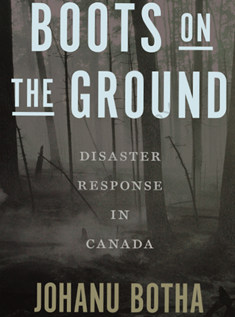 Author
Author
Johanu Botha
Reviewed by
David Parsons
Published by
University of Toronto Press
ISBN: 978-1-4875-2979-6 (PDF)
Disaster management in Canada faces many of the same challenges as in Australia. One of the contemporary issues for both countries is the role that defence forces have in emergencies and disasters. In this book, the author considers how effectively the Canadian Armed Forces have integrated into the multilevel governance of domestic disasters.
Canada has a 3-tier set of disaster arrangements involving federal, provincial and municipal responsibilities. This author’s research explored the elements required to achieve effective integration of Armed Force support with civilian agencies. Three questions explored:
- What is the role of Canadian Armed Forces in contemporary Canadian disaster response?
- How effective is the civilian-military relationship during disaster response?
- In what ways might the military contribution to Canadian natural disaster response be improved?
Public Safety Canada is a legislated federal department and is responsible for conferring with the Department of National Defence about requests for Canadian Armed Forces assistance from provinces. As in Australia, the Canadian Government receives requests for assistance principally through provincial governments. The book includes examples of situations where Canadian Armed Forces assistance was urgently supplied while waiting Canadian Government approval. This reflects Australia’s Defence Assistance to the Civil Community Initiative (DACC) Category 1 arrangements that are for localised, shortterm
emergency response.
A number of limitations are identified by the author to the use and capability of Canadian Armed Force personnel. These are that their personnel are not trained in emergency services skill sets and that there are negative perceptions of the Army by some Canadian Indigenous communities that stem from the use of Armed Forces by Quebec Province to control protests in the 1970s.
The author identifies factors that contribute to effective operational partnerships between Canadian Armed Forces and civilian agencies. The most effective civil military outcomes were associated with liaison officers being involved before disaster events in provincial emergency management planning, training and exercising. In these cases, strong relationships, clear understanding of the others’ capabilities, better understanding of emergency risks and operational procedures, situational awareness and communication flows occurred. During emergencies and disasters, liaison officers provided early identification of Provincial requests, clarified Army capability and scope with requestors and ensured people with the right knowledge were talking to each other. The author highlights the additional benefits with the deployment of reservist officers due to their local networks that improved communication flows, local information and speed in identifying contacts.
Factors limiting the civil military partnership include:
- the difficulties in meeting Armed Force’s core responsibilities while responding to disasters
- information systems used by force and by municipal governments were unable to build an integrated operating picture.
Achieving effective integration of effort between civil and military operations is identified as an issue. The critical concern relates to effective joint planning, language and terminology and expectations of civil and military leaders towards each other.
This book provides an interesting analysis of the context surrounding civil and military joint operations in emergencies and disasters. The author identifies issues to be considered to get the best outcome when civil and military resources work together. Although this is a Canadian case study, the issues can be replicated in the Australian context.


